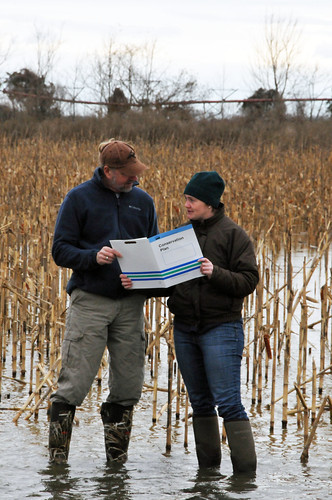
Muffled honking above draws wildlife painter Richard Clifton’s eyes to the sky. Flying overhead is a flock of nearly 30 snow geese preparing to land nearby in Clifton’s crop field in Milton, Delaware. In early March, this is a common scene due to his unique wetland ‘plant and flood’ restoration project that enhances wildlife habitat and production.
Clifton’s farming background combined with his love of duck hunting and passion for painting wildlife gives him a unique perspective on habitat enhancement. Growing up on a farm, as did his father and many generations before him, he recognizes the need to keep his fields in production agriculture. However, as an avid duck hunter, he wants additional habitat, food and breeding grounds for wildlife―all of which inspire his award-winning wildlife paintings.
“Before the project, I had crop fields with several natural low spots, and when the big rains came they held some of that water,” said Clifton. “I just didn’t want to keep taking land away from the farmer who rents cropland from me. The more that I take out, the less of a benefit it is for him.”
After deciding that he wasn’t ready to permanently convert his cropland to wetlands, Clifton contacted his local Natural Resources Conservation Service (NRCS) office about options.
“I told him that his fields were ideal for a plant and flood situation,” said NRCS Soil Conservationist Brooke Brittingham.
‘Plant and flood’ is a conservation practice in which an existing low spot in a field is shaved or bowled out more to hold water. The farmer plants crops on the entire field in the spring as usual (which in Clifton’s case is always corn). However, when it’s harvest time, the shallow area is left unharvested leaving a food source that attracts wildlife.
Part of Clifton’s project involved installing a water control structure and a berm. Although his fields don’t look as if they’ve been manipulated by any manmade activity, a water control structure equipped with risers allows water to be adjusted within the shallow water area. The berm, a high mound constructed from fill, holds the water.
The total impacted acreage on his crop fields is about two acres. Since the change, Clifton said he’s seen a lot of wildlife on his property.
“I’ve seen hundreds of ducks, Great Blue herons and American bitterns. If I let it stay wet; I also get a lot of shore birds, Wilson’s phalarope, and dowitchers,” Clifton says.
It’s a win-win situation all around for Clifton. His renter continues actively farming and duck hunting has improved. And maybe even more importantly, Clifton has his own satisfying space where he can watch birds and draw inspiration from them for his next painting. Something that dates back to his childhood.
Plant and flood was a practice of the Wildlife Habitat Incentives Program, which the 2014 Farm Bill rolled into the Environmental Quality Incentives Program (EQIP). As part of that streamlining effort, five percent of all EQIP funds are dedicated to wildlife practices.
If you’re interested in establishing or enhancing wildlife habitat on your land, call or stop by your local USDA Service Center.

